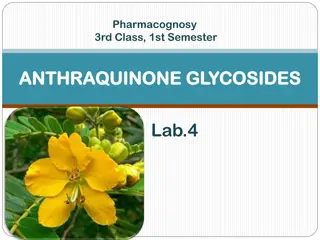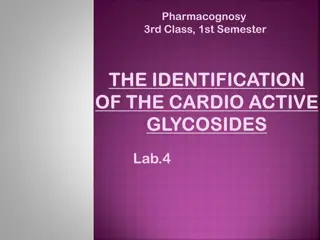Identification of Cardioactive Glycosides in Pharmacognosy Lab Experiments
The lab experiments focus on identifying cardioactive glycosides using chemical tests like Baljets Test and Keller-Killians Test, along with the identification of sterol glycosides through Raymmonds and Kedds reactions. These tests involve specific procedures with different reagents to observe color changes that indicate the presence of specific compounds. Understanding these reactions is crucial in pharmacognosy for recognizing active ingredients in natural products.
Download Presentation

Please find below an Image/Link to download the presentation.
The content on the website is provided AS IS for your information and personal use only. It may not be sold, licensed, or shared on other websites without obtaining consent from the author.If you encounter any issues during the download, it is possible that the publisher has removed the file from their server.
You are allowed to download the files provided on this website for personal or commercial use, subject to the condition that they are used lawfully. All files are the property of their respective owners.
The content on the website is provided AS IS for your information and personal use only. It may not be sold, licensed, or shared on other websites without obtaining consent from the author.
E N D
Presentation Transcript
Pharmacognosy 3rd Class, 1st Semester THE IDENTIFICATION THE IDENTIFICATION OF THE CARDIO ACTIVE OF THE CARDIO ACTIVE GLYCOSIDES GLYCOSIDES Lab.3
GENERAL CHEMICAL TESTS GENERAL CHEMICAL TESTS 1) 1) BALJETS TEST BALJETS TEST Aim The identification of the cardio active glycosides in general. Equipment and reagents Test tube Picric acid Sodium hydroxide solution Procedure 1) Take one ml of fraction A. 2) Add two drops of picric acid. 3) Make it alkaline with sodium hydroxide solution. Results Turbid, yellow to orange in color. Discussion The use of picric acid is to hydrolyze the glycoside to glycone and aglycone parts. The use of sodium hydroxide is to neutralize the acidity in the solution. The color is product due to the aglycone portion (genin).
2) 2) KELLER KELLER- -KILLIANS KILLIANS TEST TEST Aim Aim T The identification of the cardio active glycosides in general. Equipment Equipment and and reagent reagent Test tube Glacial acetic acid 0.1%of ferric chloride solution Concentrated H2SO4 Procedure Procedure 1) Take two ml of fraction A and add 3ml of glacial acetic acid. 2) Add two drops of 0.1%of ferric chloride solution. 3) Take 1ml of concentrated H2SO4 and add it to the above mixture in drops so as to make two layers. Results Results Two layers are formed: 1) The upper one has light bright green color. 2) The lower layer has transparent clear color (H2SO4 Layer) the junction appears as a reddish-brown ring
Discussion Discussion The color of the acetic acid layer is due to the genin part of the glycoside. The use of glacial acetic acid is to hydrolyze the glycoside into glycone and aglycone parts. The addition of 0.1 % ferric chloride is an oxidizing agent needed in the reaction. The H2SO4 has a high density therefore will be in the lower layer causing charring of the sugar and hence giving the reddish-brown color.
OTHER CHEMICAL TEST FOR THE IDENTIFICATION OTHER CHEMICAL TEST FOR THE IDENTIFICATION OF THE STEROL GLYCOSIDES OF THE STEROL GLYCOSIDES Sterol glycosides (SGs) occur naturally in vegetable oils and fats. 1) 1)RAYMMONDS REACTION RAYMMONDS REACTION Aim Aim To identify the sterol nucleus Equipment and reagents Equipment and reagents Test tube 10%sodium hydroxide solution 1% m-dinitrobenzene Procedure 1) To an alcoholic solution of glycoside add 1-2 drops of 10%sodium hydroxide. 2) Add few drops of an alcoholic solution of 1% m- dinitrobenzene . 3) Note the color. Results Pink color appears
2)KEDDS REACTION 2)KEDDS REACTION Aim Aim To identify the sterol nucleus Equipment and reagents Equipment and reagents Test tube 1%3, 5-dinitrobenzene acid 0.5 N aqueous methanolic KOH (50%) Procedure Procedure 1) To a solution of glycoside add a solution of 1%3, 5-dinitrobenzene acid in 0.5 N aqueous methanolic KOH (50%). 2) Report the color. Results Violet color
3 3) )LIEBERMANS STEROL REACTION LIEBERMANS STEROL REACTION Aim Aim To identify the sterol nucleus Equipment and reagents Equipment and reagents Test tube Porcelain dish Anhydrous acetic acid Concentrated H2SO4 Procedure Procedure 1) Take 5ml of the alcoholic extract in a test tube. 2) Add 5ml of the anhydrous acetic acid and shake well. 3) Take 4 drops of the above mixture and place in a porcelain dish. 4) Add 0ne drop of concentrated H2SO4. Results Results Achange of color from rose, through red , violet, and blue to green. The color is slightly different from compound to compound. Discussion Discussion This reaction is due to the steroidal part of the molecule and it is characteristic of the aglycone of the scillarenin type (unsaturated steroidal part)
LEGALS REACTION LEGALS REACTION The glycoside or the purified extract of the crude drug is dissolved in pyridine. When sodium hydroxide and sodium nitroprusside are added alternatively, a transient blood red color develops. This is a test for the unsaturated lactone ring of the genin. Cardenolide in pyridine + Na nitroprusside + NaOH Deep red colour
THE IDENTIFICATION OF CARDIO ACTIVE THE IDENTIFICATION OF CARDIO ACTIVE GLYCOSIDE BY CHROMATOGRAPHY GLYCOSIDE BY CHROMATOGRAPHY By the use of thin layer chromatography (T.L.C) The stationary phase=silica gel G The mobile phase Chloroform: Ethanol: Water (7:3:1) Or Ethyl acetate: Methanol: Water (75:10:5) The standard compound =Oleanderin, Digoxin The spray reagent=Lieberman's reagent. Other mobile phase as Butanone: Xylene: Formamide (50:5:4) Chloroform: Tetrahydrofuran: Formamide(50:50:6)
Procedure Procedure 1) Prepare 100ml of the mobile phase; place it in the glass tank. 2) Cover the tank with glass lid and allow standing for 45 minutes before use. 3) Apply the sample spots (fraction A and fraction B) and the standard spot, on the silica gel plates, on the base line. 4) Put the silica gel plate in the glass tank and allow the mobile phase to raise to about two- third the plate. 5) Remove the plate from the tank. 6) Allow drying and then detecting the spots by use of the spray reagent and heat the plate at 105-110c for 5-10 minutes in the oven. 7) Note the spots, and calculate the RF value for each spot. Note:- The RF value= distance moved by the sample /distance moved by the solvent. The RF value should be less than 1 because if the RF value=1 this means that there is no separation, and the sample moved with the solvent.
THANK YOU THANK YOU























